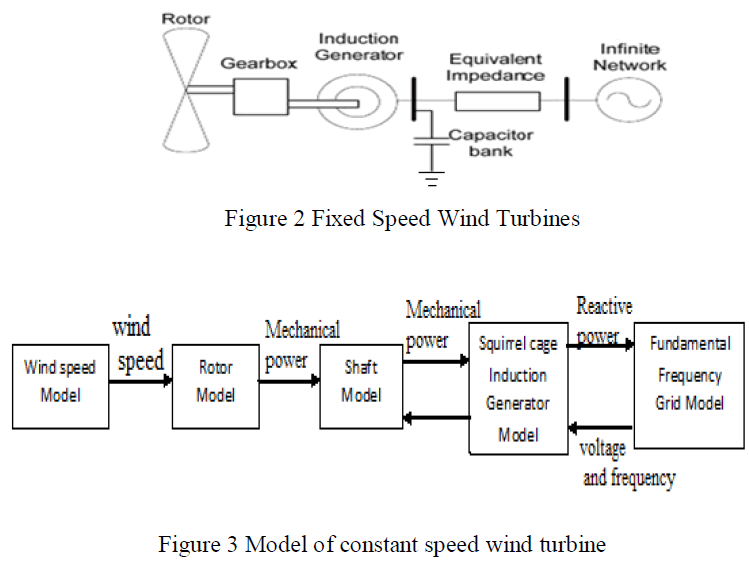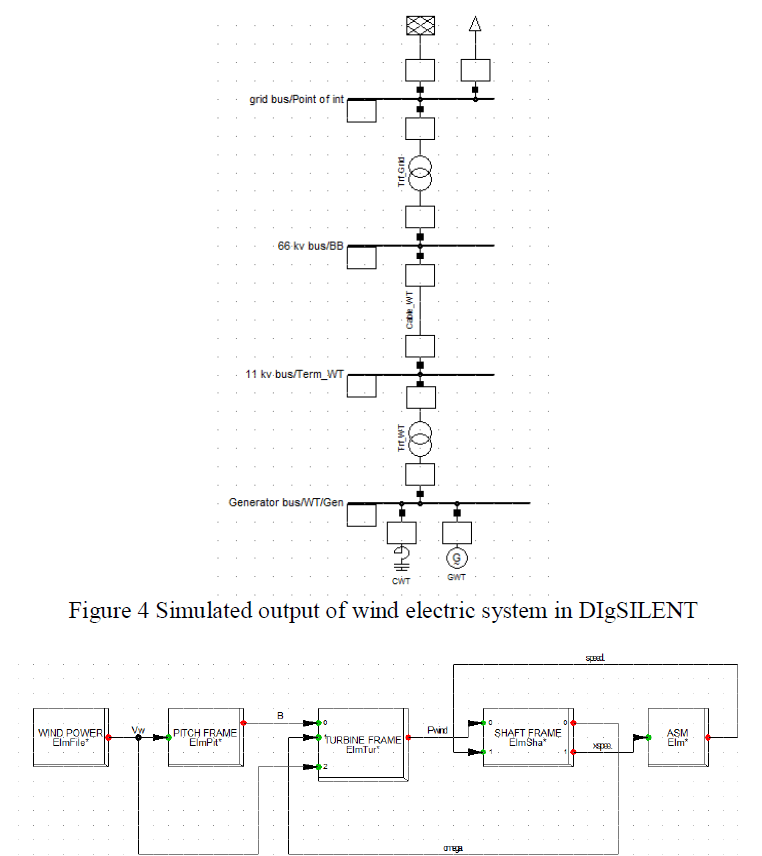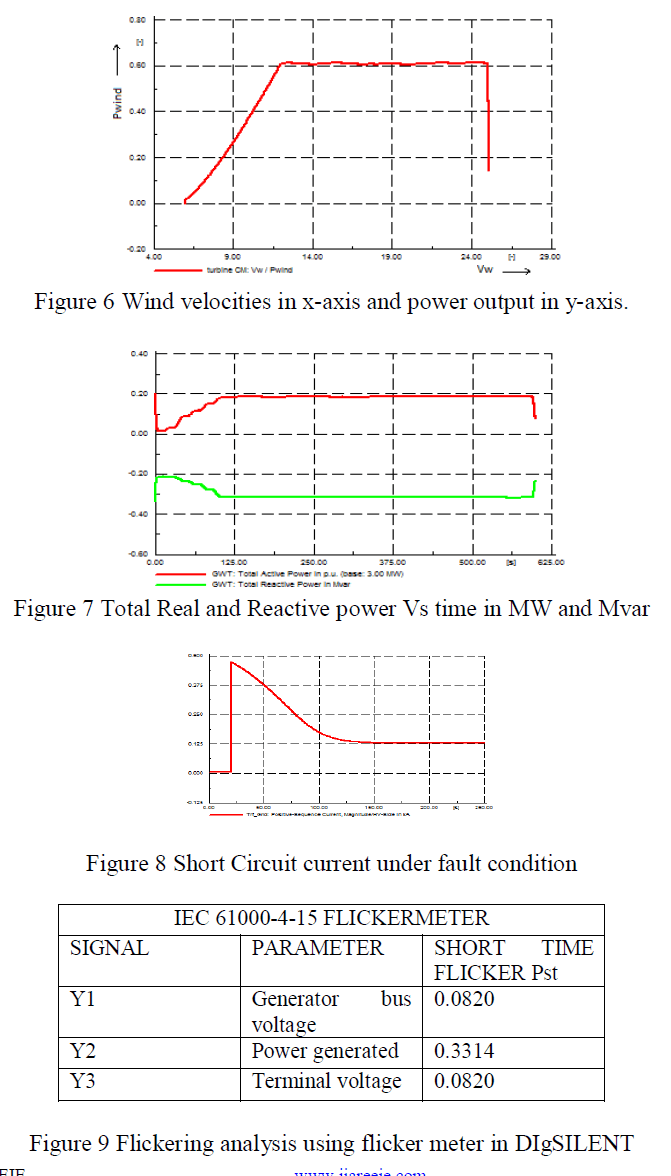ISSN ONLINE(2278-8875) PRINT (2320-3765)
ISSN ONLINE(2278-8875) PRINT (2320-3765)
Gayathri S#1, Chellamuthu C#2
|
| Related article at Pubmed, Scholar Google |
Visit for more related articles at International Journal of Advanced Research in Electrical, Electronics and Instrumentation Engineering
The paper describes the dynamic wind turbine models implementation in power system simulation tools DIgSILENT POWER FACTORY. The overall objective is to create a model database to support the analysis of the integration between the mechanical structure of the wind turbine and electrical grid. The paper contains description of the models developed in the dynamic simulation language DSL of DIgSILENT, for the non-electrical components of the wind turbine (wind turbine model, aerodynamic model, and mechanical model). The initialization issues on wind turbine models into the power system simulation are also performed. However the main attention of this project is to model the wind turbine concept: 1. Fixed speed wind turbine with pitch angle control using squirrel cage induction generator. 2. Dynamic analysis such as short circuit analysis for the load flow model and flicker analysis are made. These wind turbine concept model is extended for the study of different aspects, e.g. the assessment of power quality, control strategies, connection of the wind turbine at grid and storage systems. For these concepts, control strategies are developed and implemented. Their performance assessed and discussed by means of simulation.
Keywords |
| DIgSILENT-Digital Simulation and Electrical Network calculation program, DSLDIgSILENT Simulation language, Pitch angle control. |
INTRODUCTION |
| The fast rise in Industrialization, Information Technology sector and development in retail sector, electrical power requirements have increased significantly. There is large gap between supply side and load side demand. In this situation alternate energy sources (renewable sources) can play an important role to overcome this electric power gap. Out of many alternate sources for generation of electricity, wind energy is the most promising. Electrical Power Quality is the degree of any deviation from the nominal values of the voltage magnitude and frequency. “Power Quality” is a term used to describe the most important aspect of the electricity supply. It covers several types of problems of electricity supply and power system disturbances. This utility oriented factor is a subjective one of many objectives with various constraints. In the eyes of power system engineer it focuses on the broad perspective of Quality, economy, stability, reliability, security and safety. Power Quality has become very important issue over the last decade. A key reason for the increasing importance is the rapid spread of the use of equipment’s sensitive to power system disturbances and the widespread use of non-linearly behaving power electronic converters. The addition of wind Turbines can have a significant effect and increases the complexity of this problem. Depending on the grid configuration and the type of wind turbine used, different power quality problems may arise. The calculation program Power Factory, as written by DIgSILENT, is a computer aided engineering tool for the analysis of transmission, distribution, and industrial electrical power systems. It has been designed as an advanced integrated and interactive software package dedicated to electrical power system and control analysis in order to achieve the main objectives of planning and operation optimization. The name DIgSILENT stands for "Digital Simulation and Electrical Network calculation program''. DIgSILENT Version 7 was the world's first power system analysis software with an integrated graphical one-line interface. |
II CHARACTERISTICS OF WIND TURBINE |
| The Wind turbine can be characterized by its ïÿýïÿýïÿýïÿý-TSR curve, where the Tip speed ratio is the ratio to the wind speed. It shows that the power co efficient varies with respect to wind speed. It is shown that the power coefficient cp varies with the tip-speed ratio. It is assumed that the variable wind turbine is operated at high cpvalues most of the time. In a fixed frequency application, the rotor speed of the induction generator varies by a small percentage (based on the slip) above the synchronous speed while the speed of the wind may vary across a wide range. From (1), the tipspeed ratio for a fixed wind turbine varies across a wide range depending on the wind speed. In figure 2, the change of the cp-TSR curve as the pitch angle is adjusted is also shown. In low to medium wind speeds, the pitch angle is controlled to allow wind turbine to operate at its optimum condition. In the high-wind-speed region, the pitch angle is increased to shed some of the aerodynamic power. |
| The power captured by wind turbine may be written as (2). From (2), it is apparent that the power production from the wind turbine can be maximized if the system is operated at maximumïÿýïÿýïÿýïÿý. |
 |
 |
| The characteristics of the wind turbine for the power co-efficient (Cp) versus lambda (ïÿýïÿý) is performed using the simulation software DIgSILENT is shown in figure 1. |
III FIXED SPEED WIND TURBINE |
| This section presents a number of basic considerations regarding simulations for fixed speed wind turbines with squirrel cage induction generator directly connected to grid (Figure 2). We focus on modeling of wind turbine and the main objective is also look at the wind turbine as one electromechanical component among many others in the entire power system. |
 |
| Figure 1 Fixed speed wind turbine with induction generator In order to put a reasonable limit on data requirement and computation time, quasi static approach is used to describe the rotor of wind turbine. Dynamic behaviour is the main interest in this project, and low frequencies phenomenon with long time constants, due only fundamental frequency component of voltage and current is taking into account. Network representation is by constant admittance matrix, neglecting differential equation associated with network. Figure 2 depicts general structure of a model of a constant speed wins turbine. Main model of the most important subsystem, namely the rotor, the drive train, and the generator, combined with a wind speed model. |
IV SIMULATION AND RESULTS |
| Steady state analysis and dynamic analysis of grid connected wind generator helps us to analyze the system performance under the constant wind flow and load condition. The variation in grid voltage, frequency, wind speeds are considered to observe the system behaviour. |
 |
| Figure 5 Frame definitions to form slots to integrate all the blocks such as Turbine block, Shaft model block, and Pitch angle controller block, built in model of Induction Machine (ASM block) are connected together through the slot with help of Frame definition. |
 |
V CONCLUSION |
| This paper illustrates that the steady state and dynamic analysis of the wind turbine fed induction generated is simulated and the results are obtained for various issues like short-circuits and flickering are analysed. This work can be further improved by analysing the voltage sag, harmonics and various power quality issues. |
References |
|